Albert Q. Jiang
End-to-End Ontology Learning with Large Language Models
Oct 31, 2024Abstract:Ontologies are useful for automatic machine processing of domain knowledge as they represent it in a structured format. Yet, constructing ontologies requires substantial manual effort. To automate part of this process, large language models (LLMs) have been applied to solve various subtasks of ontology learning. However, this partial ontology learning does not capture the interactions between subtasks. We address this gap by introducing OLLM, a general and scalable method for building the taxonomic backbone of an ontology from scratch. Rather than focusing on subtasks, like individual relations between entities, we model entire subcomponents of the target ontology by finetuning an LLM with a custom regulariser that reduces overfitting on high-frequency concepts. We introduce a novel suite of metrics for evaluating the quality of the generated ontology by measuring its semantic and structural similarity to the ground truth. In contrast to standard metrics, our metrics use deep learning techniques to define more robust distance measures between graphs. Both our quantitative and qualitative results on Wikipedia show that OLLM outperforms subtask composition methods, producing more semantically accurate ontologies while maintaining structural integrity. We further demonstrate that our model can be effectively adapted to new domains, like arXiv, needing only a small number of training examples. Our source code and datasets are available at https://github.com/andylolu2/ollm.
Pixtral 12B
Oct 09, 2024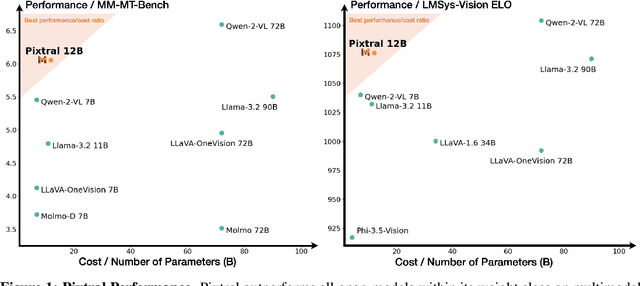
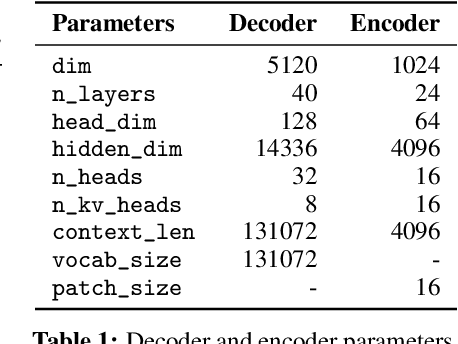
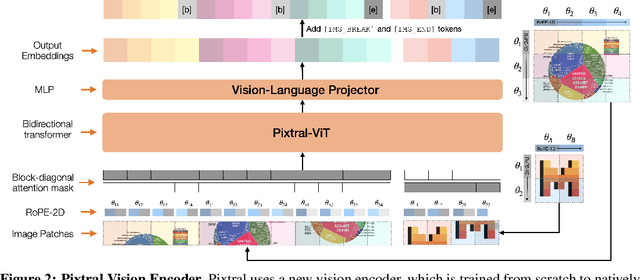
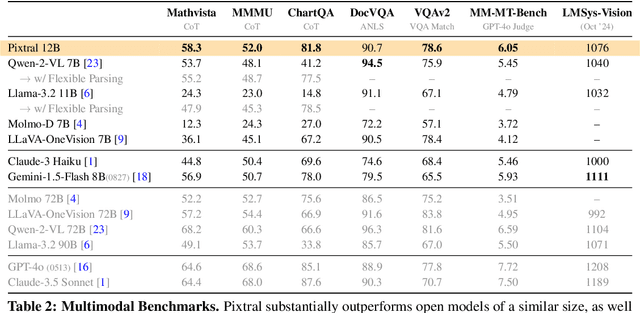
Abstract:We introduce Pixtral-12B, a 12--billion-parameter multimodal language model. Pixtral-12B is trained to understand both natural images and documents, achieving leading performance on various multimodal benchmarks, surpassing a number of larger models. Unlike many open-source models, Pixtral is also a cutting-edge text model for its size, and does not compromise on natural language performance to excel in multimodal tasks. Pixtral uses a new vision encoder trained from scratch, which allows it to ingest images at their natural resolution and aspect ratio. This gives users flexibility on the number of tokens used to process an image. Pixtral is also able to process any number of images in its long context window of 128K tokens. Pixtral 12B substanially outperforms other open models of similar sizes (Llama-3.2 11B \& Qwen-2-VL 7B). It also outperforms much larger open models like Llama-3.2 90B while being 7x smaller. We further contribute an open-source benchmark, MM-MT-Bench, for evaluating vision-language models in practical scenarios, and provide detailed analysis and code for standardized evaluation protocols for multimodal LLMs. Pixtral-12B is released under Apache 2.0 license.
Repurposing Language Models into Embedding Models: Finding the Compute-Optimal Recipe
Jun 06, 2024



Abstract:Text embeddings are essential for many tasks, such as document retrieval, clustering, and semantic similarity assessment. In this paper, we study how to contrastively train text embedding models in a compute-optimal fashion, given a suite of pre-trained decoder-only language models. Our innovation is an algorithm that produces optimal configurations of model sizes, data quantities, and fine-tuning methods for text-embedding models at different computational budget levels. The resulting recipe, which we obtain through extensive experiments, can be used by practitioners to make informed design choices for their embedding models. Specifically, our findings suggest that full fine-tuning and low-rank adaptation fine-tuning produce optimal models at lower and higher computational budgets respectively.
Mixtral of Experts
Jan 08, 2024



Abstract:We introduce Mixtral 8x7B, a Sparse Mixture of Experts (SMoE) language model. Mixtral has the same architecture as Mistral 7B, with the difference that each layer is composed of 8 feedforward blocks (i.e. experts). For every token, at each layer, a router network selects two experts to process the current state and combine their outputs. Even though each token only sees two experts, the selected experts can be different at each timestep. As a result, each token has access to 47B parameters, but only uses 13B active parameters during inference. Mixtral was trained with a context size of 32k tokens and it outperforms or matches Llama 2 70B and GPT-3.5 across all evaluated benchmarks. In particular, Mixtral vastly outperforms Llama 2 70B on mathematics, code generation, and multilingual benchmarks. We also provide a model fine-tuned to follow instructions, Mixtral 8x7B - Instruct, that surpasses GPT-3.5 Turbo, Claude-2.1, Gemini Pro, and Llama 2 70B - chat model on human benchmarks. Both the base and instruct models are released under the Apache 2.0 license.
Multilingual Mathematical Autoformalization
Nov 09, 2023Abstract:Autoformalization is the task of translating natural language materials into machine-verifiable formalisations. Progress in autoformalization research is hindered by the lack of a sizeable dataset consisting of informal-formal pairs expressing the same essence. Existing methods tend to circumvent this challenge by manually curating small corpora or using few-shot learning with large language models. But these methods suffer from data scarcity and formal language acquisition difficulty. In this work, we create $\texttt{MMA}$, a large, flexible, multilingual, and multi-domain dataset of informal-formal pairs, by using a language model to translate in the reverse direction, that is, from formal mathematical statements into corresponding informal ones. Experiments show that language models fine-tuned on $\texttt{MMA}$ produce $16-18\%$ of statements acceptable with minimal corrections on the $\texttt{miniF2F}$ and $\texttt{ProofNet}$ benchmarks, up from $0\%$ with the base model. We demonstrate that fine-tuning on multilingual formal data results in more capable autoformalization models even when deployed on monolingual tasks.
Llemma: An Open Language Model For Mathematics
Oct 16, 2023



Abstract:We present Llemma, a large language model for mathematics. We continue pretraining Code Llama on the Proof-Pile-2, a mixture of scientific papers, web data containing mathematics, and mathematical code, yielding Llemma. On the MATH benchmark Llemma outperforms all known open base models, as well as the unreleased Minerva model suite on an equi-parameter basis. Moreover, Llemma is capable of tool use and formal theorem proving without any further finetuning. We openly release all artifacts, including 7 billion and 34 billion parameter models, the Proof-Pile-2, and code to replicate our experiments.
Mistral 7B
Oct 10, 2023



Abstract:We introduce Mistral 7B v0.1, a 7-billion-parameter language model engineered for superior performance and efficiency. Mistral 7B outperforms Llama 2 13B across all evaluated benchmarks, and Llama 1 34B in reasoning, mathematics, and code generation. Our model leverages grouped-query attention (GQA) for faster inference, coupled with sliding window attention (SWA) to effectively handle sequences of arbitrary length with a reduced inference cost. We also provide a model fine-tuned to follow instructions, Mistral 7B -- Instruct, that surpasses the Llama 2 13B -- Chat model both on human and automated benchmarks. Our models are released under the Apache 2.0 license.
Evaluating Language Models for Mathematics through Interactions
Jun 02, 2023Abstract:The standard methodology of evaluating large language models (LLMs) based on static pairs of inputs and outputs is insufficient for developing assistants: this kind of assessments fails to take into account the essential interactive element in their deployment, and therefore limits how we understand language model capabilities. We introduce CheckMate, an adaptable prototype platform for humans to interact with and evaluate LLMs. We conduct a study with CheckMate to evaluate three language models~(InstructGPT, ChatGPT, and GPT-4) as assistants in proving undergraduate-level mathematics, with a mixed cohort of participants from undergraduate students to professors of mathematics. We release the resulting interaction and rating dataset, MathConverse. By analysing MathConverse, we derive a preliminary taxonomy of human behaviours and uncover that despite a generally positive correlation, there are notable instances of divergence between correctness and perceived helpfulness in LLM generations, amongst other findings. Further, we identify useful scenarios and existing issues of GPT-4 in mathematical reasoning through a series of case studies contributed by expert mathematicians. We conclude with actionable takeaways for ML practitioners and mathematicians: models which communicate uncertainty, respond well to user corrections, are more interpretable and concise may constitute better assistants; interactive evaluation is a promising way to continually navigate the capability of these models; humans should be aware of language models' algebraic fallibility, and for that reason discern where they should be used.
Autoformalization with Large Language Models
May 25, 2022

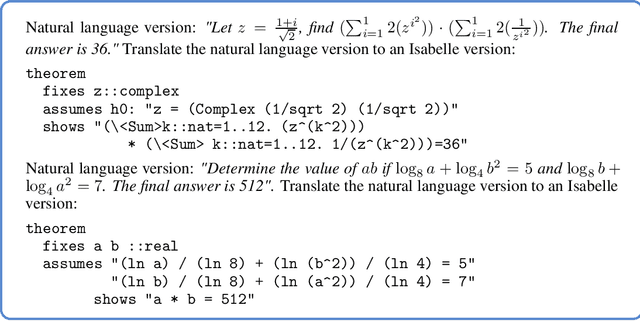

Abstract:Autoformalization is the process of automatically translating from natural language mathematics to formal specifications and proofs. A successful autoformalization system could advance the fields of formal verification, program synthesis, and artificial intelligence. While the long-term goal of autoformalization seemed elusive for a long time, we show large language models provide new prospects towards this goal. We make the surprising observation that LLMs can correctly translate a significant portion ($25.3\%$) of mathematical competition problems perfectly to formal specifications in Isabelle/HOL. We demonstrate the usefulness of this process by improving a previously introduced neural theorem prover via training on these autoformalized theorems. Our methodology results in a new state-of-the-art result on the MiniF2F theorem proving benchmark, improving the proof rate from $29.6\%$ to $35.2\%$.
Thor: Wielding Hammers to Integrate Language Models and Automated Theorem Provers
May 22, 2022
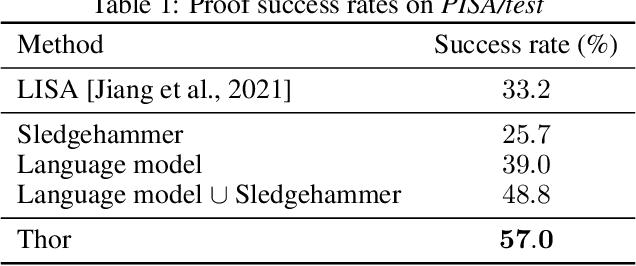

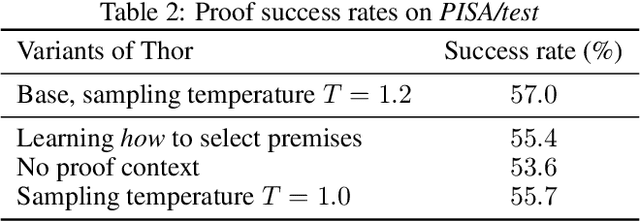
Abstract:In theorem proving, the task of selecting useful premises from a large library to unlock the proof of a given conjecture is crucially important. This presents a challenge for all theorem provers, especially the ones based on language models, due to their relative inability to reason over huge volumes of premises in text form. This paper introduces Thor, a framework integrating language models and automated theorem provers to overcome this difficulty. In Thor, a class of methods called hammers that leverage the power of automated theorem provers are used for premise selection, while all other tasks are designated to language models. Thor increases a language model's success rate on the PISA dataset from $39\%$ to $57\%$, while solving $8.2\%$ of problems neither language models nor automated theorem provers are able to solve on their own. Furthermore, with a significantly smaller computational budget, Thor can achieve a success rate on the MiniF2F dataset that is on par with the best existing methods. Thor can be instantiated for the majority of popular interactive theorem provers via a straightforward protocol we provide.
 Add to Chrome
Add to Chrome Add to Firefox
Add to Firefox Add to Edge
Add to Edge